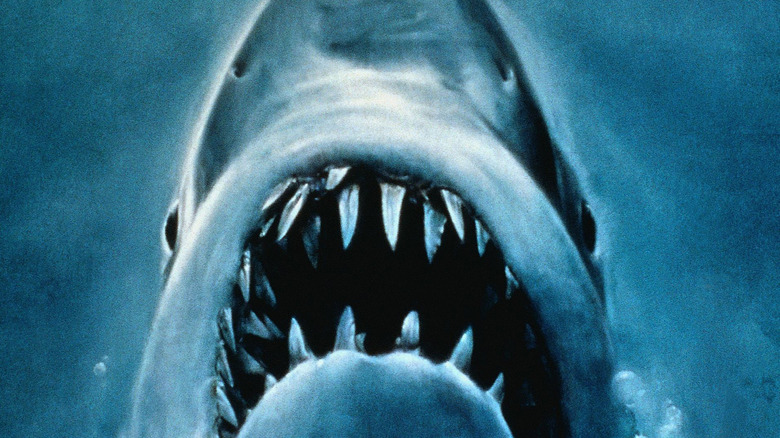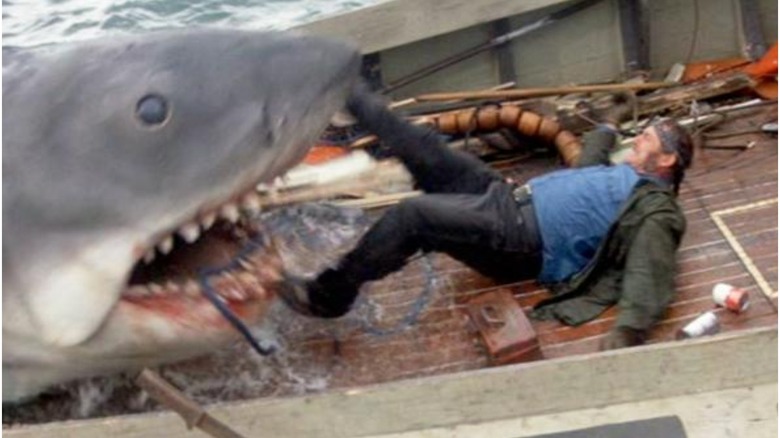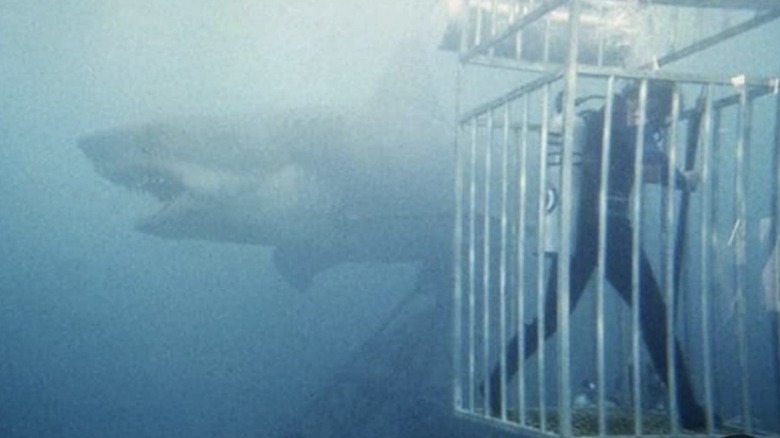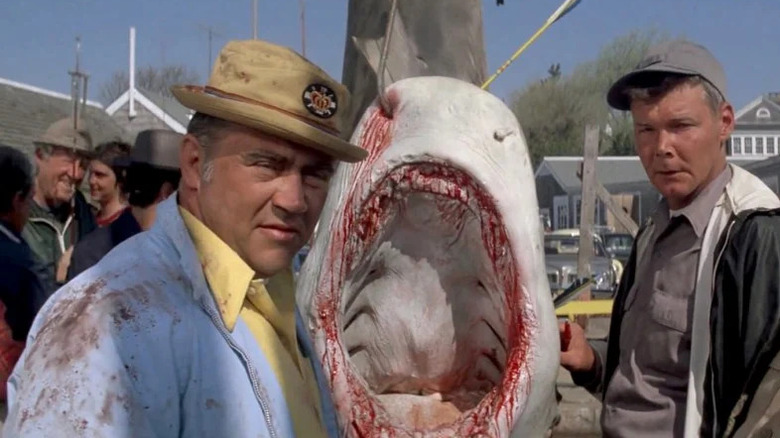All The Trouble That Real Sharks Caused The Jaws Shoot
Few films are as influential as Steven Spielberg's "Jaws." It was Spielberg's breakout hit, it turned the summer into blockbuster movie season, and, alongside its novel source material, the film shaped public perception of sharks; author and screenplay co-writer Peter Benchley has his regrets there.
This fantastic success was a happy ending for a production so plagued by problems it inspired a stage play retelling. For a more direct behind-the-scenes look, there's "The Jaws Log," first published in 1975, the same year as the film. Authored by "Jaws" co-writer Carl Gottlieb, the book offers an inside view of the movie's production from beginning to end. Many of the wildest anecdotes concern real sharks.
Training a shark
For much of history, sharks haven't been widely understood. In the article "Seeing Jaws: The Role of Shark Science in Ocean Conservation," Jennifer A. Martin writes that before the 20th century, sharks were, "unseen, liminal creatures, inhabitants of the marine wilderness." In "Jaws," Hooper's scientific exposition and the scene where Brody skims a shark encyclopedia are for the audience's benefit as much as the characters. "Jaws" was the culmination of decades-long building fear, caused by incidents such as a series of shark attacks on the Jersey shore in 1916, or the sinking of the USS Indianapolis, referenced in one of the best scenes in "Jaws."
Since most people knew little of sharks, and the little they did know scared them, a monster movie about a shark made sense. However, this lack of awareness led to initial uncertainty about how to make the movie. Gottlieb recounts in "The Jaws Log" that producers Richard D. Zanuck and David Brown, "innocently assumed they could get a shark trainer somewhere who ... could get a Great White Shark to perform a few simple stunts on cue in long shots with a dummy in the water, after which they could cut to miniatures or something for the close-up stuff."
For reference, Great Whites aren't even held in captivity or for exhibition, much less trained. Bottlenose dolphins, sharks are not. Thus, special effects artist Bob Mattey came out of retirement to build three mechanical shark replicas, affectionately nicknamed "Bruce" after Steven Spielberg's lawyer. Bruce may have been difficult to work with, but the crew got a masterpiece for their trouble. Trying to train a shark would've been a disaster and an unfruitful one at that.
Great White B-Roll
Not all the shark footage was shot with Bruce, though. Before principal photography kicked off on Martha's Vineyard, Massachusetts, a second unit team went to Australia to shoot B-roll footage of a real Great White Shark. These shots would be used in the scene where Hooper (Richard Dreyfuss) dives in a shark cage. The second unit team employed Ron and Valerie Taylor, a pair of Australian divers who had shot underwater footage for several shark documentaries. The problem was, as Valerie would later say, "You might be able to direct a dog or a human or a horse, but you can't direct a shark." The shark's unpredictability wound up shaping the film's story.
In Benchley's novel, Hooper is killed by the shark. This was meant to happen in the film, but as Valerie Taylor would recount to InsideHook in 2021, two accidents changed this. One, the stuntman they hired turned out to have no diving experience and was too terrified to go in the cage. Second, a shark became caught in the cage and thrashed it to pieces; Ron Taylor captured this and the footage was too stunning not to use. Since the cage was empty though, they decided to rewrite the script so that Hooper escaped the cage, hid underwater as Brody (Roy Scheider) defeated the shark, and then swam off into the sunset.
In my humble opinion, this change benefitted the movie. Brody as the sole survivor is too dour a concluding note. Quint karmically earns his death by stranding the trio at sea so he may quench his vengeful thirst. Hooper's death would have been an ironic one for a man who admittedly "love[s] sharks," but he wasn't deserving of such a fate.
Getting The Tiger Shark
The titular Great White isn't the only shark in "Jaws." Early on, a group of fishermen catches a Tiger Shark who they believe to be the man-eater terrorizing Amity Island. This is a short-lived red herring; Hooper proves the Tiger Shark isn't the culprit. This shark was a real one, a 13-footer which had been caught off the coast of Sarasota, Florida. In Chapter 10 of "The Jaws Log," "Teddy, We've Gotta Have a Shark by Monday," Gottlieb reveals how the crew got the shark up to Martha's Vineyard.
The crew initially hired local fishermen to catch a shark, but none were big enough to pass as a man-eater. By Thursday, June 6, they still had no shark for a scene set to shoot Monday, June 10. Worse, the special effects team was too busy to whip something up. Teddy Grossman, an uncredited stunt coordinator and stunt double for Scheider, called up a friend of his in Florida and learned the state had good shark fishing. Thus, Grossman and Fred Zendar, a technical advisor nicknamed "the Ancient Mariner," flew down to the Sunshine State.
Even once they caught the shark, their troubles weren't over.
"There [was] no commercial airline that want[ed] to take a fifteen-foot wooden casket containing the recently demised corpse of a 750-pound shark as carry-on luggage," Gottlieb recounts. Still, Grossman and Zendar needed to get the shark to the shoot quickly, both due to the schedule and since shark proteins degrade rapidly. Producer Bill Gilmore came to the rescue, sending a private jet to transport the two and their cargo back.
The final kicker? There wasn't enough room for the shark and two passengers, so Grossman still had to fly back commercial.



